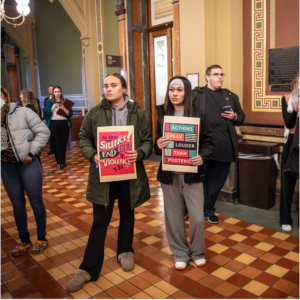17 year-old Alia Saphier looks at possible solutions to the epidemic of gun violence in US schools

January 8, 2024. Students in Des Moines and area suburbs hold a protest at the State Capitol after the school shooting nearby in Perry, Iowa.
July 11, 2024
Are Americans normalising school shootings?
Trigger warning: gun violence, school shootings.
A voice comes over the speakers. Everyone knows where to go. It’s either a small closet, under the desks, or a boiler room usually. We’re not supposed to talk, but people do, thinking this could never happen to us.
These active shooter drills have become so common that no one really thinks about what they are for. As an American high school student, these drills are part of my school life, happening almost every month. And it’s not just my school. Others throughout the nation are in a constant state of alert as school shootings become more frequent with 95% of US public schools having some sort of lockdown procedure.
According to a non-profit organization committed to preventing gun violence, Sandy Hook Promise, 12 children die every day from gun violence in the US, while another 32 children are shot and injured. So far in 2024, there have been 115 school-related gun incidents, resulting in 31 deaths and 65 injuries.
What I sometimes forget is that these shootings are not common in other parts of the world. In 2018, CNN reported that the US had 57 times as many school shootings than those of the six other G7 countries (Canada, France, Germany, Italy, Japan, UK) combined.
So, what is a school shooting? One definition is ‘an event in which a student at an educational institution… shoots and injures or kills at least one other student or faculty member on the grounds of that institution.’
One of the most infamous is the Sandy Hook Elementary School shooting, on December 14, 2012, in Newton, Connecticut, in which 26 people (students and staff) died and two were injured. The murders were conducted by 20 year-old Adam Lanza, who killed his mother before he began the shooting at the school.
But shootings don’t always make headlines around the world. One example occurred at Oxford High School in Detroit, in which 15 year-old high school sophomore Ethan Crumbley killed four students and injured seven others. This shooting was the deadliest in Michigan history, and it occurred on November 30, 2021. However, they are not only a recent phenomenon.
I learned that school shootings do (occasionally) happen in other countries; the difference is that those countries addressed them head-on. When a primary school shooting occurred in Dunblane, Scotland in 1996 that resulted in the death of 16 children and their teacher, the UK passed legislation that outlawed the ownership of most handguns. Automatic and semi-automatic rifles had already been banned.
Another example is Germany. After a 19 year-old gunman killed 16 people at his former school in 2002, the country banned all automatic weapons and created a requirement of a psychological exam for all gun buyers under the age of 25.
So what are we, as Americans, doing wrong?
The politics of gun control
One aspect that needs to be considered when reviewing the efficacy of US gun policy, both in terms of its passing into national law and its implementation, in comparison to other nations, is the form of government in the United States.
The US Constitution was created so that there would be a system of checks and balances, to ensure that no branch of government outweighs another. Congress can pass legislation that affects the whole nation, as long as that piece of legislation is not deemed constitutional, it is applicable throughout the nation. On a lower level, states can individually pass their own laws that are applicable within their borders. Because Congress has failed to pass any gun control measures, it is essentially up to the states to decide their own regulations.
An analysis from Harvard University discusses the trade-offs between the size of a country and its heterogeneity, suggesting that smaller, more homogeneous countries might find it easier to implement uniform national policies.
Within the US there are two main arguments regarding gun control. Those in favour of gun control emphasise the importance of protecting children within a school system in which they should feel safe. Those against gun control rely on the “right to bear arms” outlined in the Second Amendment to the US Constitution. Such an amendment was formed in the context of the American Revolution, where the British colonial government confiscated the patriots’ weapons.
Learn more:
However, it is not just the actual Second Amendment that permits violations of gun use. According to Professor Adam Winkler from the UCLA School of Law, it is the “aspirational Second Amendment” – how the amendment is used in political dialogue – that is key to the expansion of gun rights.
In particular, a wide range of state laws protecting the right to have and bear arms stand in the way of larger gun protection legislation.
Some possible solutions
According to research by the gun violence prevention organisation Everytown, around 76% of school shooters aged under 18 got their gun from their own home or that of a close relative. One of their proposed solutions is to implement laws that hold gun owners accountable for access gained to that firearm by an underage member of their household.
Another suggestion is to raise the age at which you can buy a gun, from 18 to 21. According to Everytown, 18– to 20-year-olds commit triple the rate of gun homicides compared to those aged 21 and above.
Everytown also recommends strengthening and empowering background checks. Currently, only licensed gun sellers have to conduct a background check on prospective buyers. Non-dealers (who sell weapons online or at gun shows, for example) are not required to run checks – a loophole that is exploited by people who would otherwise not be allowed to buy a gun.
However, both these solutions are beyond the remit of the ordinary citizen. So what can we do? New York State’s guide to gun safety provides a clear outline of what various groups of people can do to protect themselves from gun violence, and hopefully prevent future violence.
For students, they emphasise the importance of settling disputes with conversations and not violence, as well as notifying a trusted adult if they feel threatened. For parents, they list the importance of truly listening and taking their child’s concerns seriously. For school staff, the document recommends identifying safety objectives and implementing training programs to resolve conflicts so they do not become violent.
Gun control and school shootings go hand in hand. With more control, the US will be better able to reduce the sheer number of firearms in the country and, as a result, the number of school shootings. Beyond this, revised or new legislation could create more thorough background checks or place greater responsibility on gun owners.
More actions on both a local and individual level allow us to be active participants in the reduction of school shootings. We can pressure larger bodies to do what is necessary to protect our youth in their place of education.




